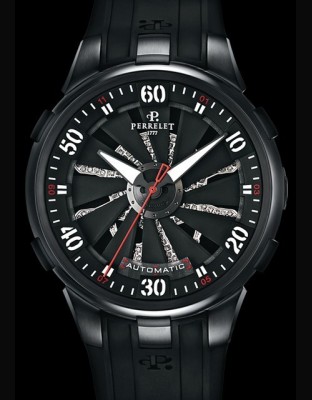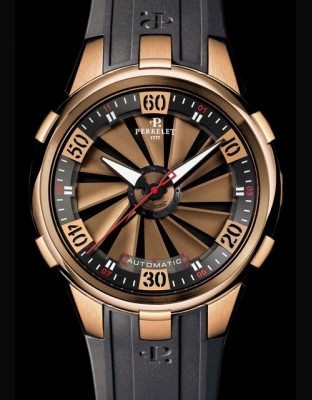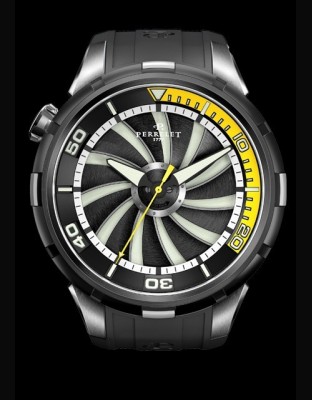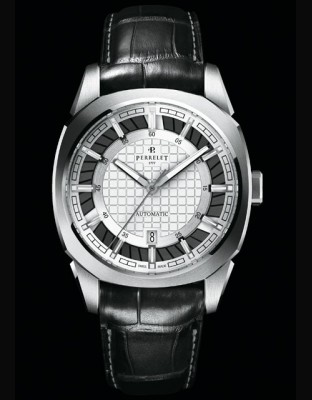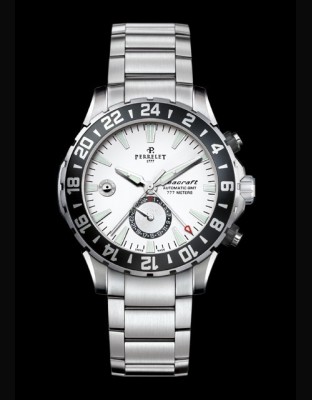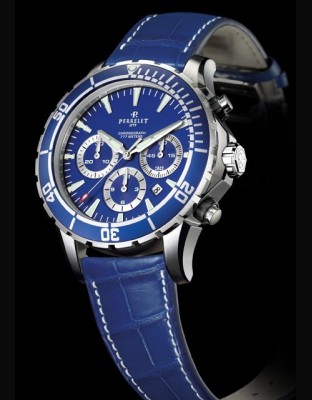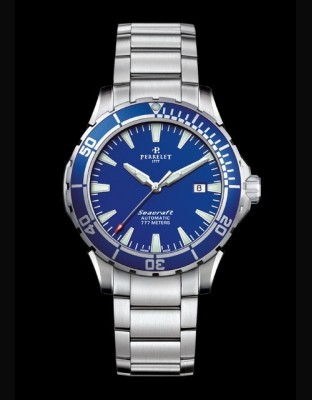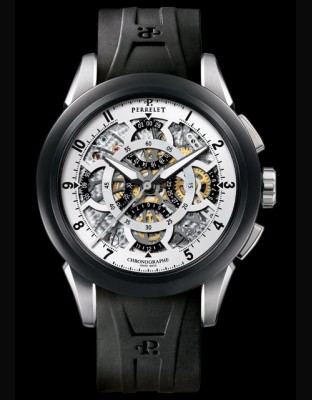1
perrelet

|
||
Abraham-Louis & Louis-Frédéric Perrelet
ABRAHAM-LOUIS PERRELET in perpetual movement
Who would have imagined on 9 January 1729 that this little boy who had just arrived in this world in the mountains of the Neuchâtel region, was destined to become a master in his field? More than two centuries later he's a respected and much admired personality, and the historians are still paying homage to this great man.
Gifted with exceptional talents, he was one of those admirable inventors, endowed with a human quality and humility, which were enhanced wi...

THE COLLECTIONS

-
Turbine Toxic XL
SEE THE DATA SHEETBrand: Perrelet
Collection: Double Rotor
Ref: A4023/1
Price: 7 250 € -
Turbine XL Gold
SEE THE DATA SHEETBrand: Perrelet
Collection: Double Rotor
Ref: A3030/1
Price: 24 900 € -
-
-
-
Peripheral Double Rotor
SEE THE DATA SHEETBrand: Perrelet
Collection: Peripheral Double...
Ref: A1061/1
Price: 3 550 € -
-
-
-
-
-
-
Seacraft 3 aiguilles-date
SEE THE DATA SHEETBrand: Perrelet
Collection: Diver
Ref: A1053/C
Price: 2 700 € -
Seacraft 3 aiguilles-date
SEE THE DATA SHEETBrand: Perrelet
Collection: Diver
Ref: A1053/2
Price: 2 550 € -
Chrono Squelette
SEE THE DATA SHEETBrand: Perrelet
Collection: Classic Collection
Ref: A1056/1
Price: 5 650 €
Abraham-Louis & Louis-Frédéric Perrelet
ABRAHAM-LOUIS PERRELET in perpetual movement
Who would have imagined on 9 January 1729 that this little boy who had just arrived in this world in the mountains of the Neuchâtel region, was destined to become a master in his field? More than two centuries later he's a respected and much admired personality, and the historians are still paying homage to this great man.
Gifted with exceptional talents, he was one of those admirable inventors, endowed with a human quality and humility, which were enhanced with intelligence, genius, know-how and passion.
It was at the family farm in Le Locle, under the attentive eye of Abraham-Louis, that during the long winter days, Daniel Perrelet, his farmer and carpenter father, manufactured some extremely refined tools for the watchmakers of the region,. Thus under the influence of this enterprising father, he was introduced at a very early age to little jobs, such as the filing down of saws and the making of small bellows. He quickly became extremely interested in these watchmaking trades, which kept on developing at the beginning of the century. With the approach of manhood, he decided to go into them on a full-time basis, already aware that his life was going to very much involved with what he was producing. His ingenuity overcame all obstacles. In the face of a lack of inadequate tooling, he set about producing a certain number of precision instruments. He is notably credited with inventing the driving-in tool and the machine for filing cogs. Finally he got round to the heart of his main objective - or rather of his very soul: the watch movement.
Could one conceive a mechanism which, from one single initial impulse, would continue to function indefinitely? This was the question that occupied the mind of our inventor. This problem had no solution: the laws of modern physics had swept aside this old dream once and for all. Nevertheless, Abraham-Louis Perrelet was the craftsman who came closest to the impossible solution. From that moment, Abraham-Louis Perrelet devoted most of his efforts to devising a system that would replace the task of winding one's watch every day. He kept on innovating, and applying his intelligence, imagination and clearsightedness and he completed a series of new techniques destined to improve the running of timekeepers. Around 1770, he embarked on finding an absolutely simple yet effective solution to wind a watch that was, unbeknown to him at the time, going revolutionize the world of watch making. He was the first to develop a rotating, oscillating weight (the so-called "rotor") mounted on the movement that follows the movements of the wearer and thus serves to wind the mainspring of the movement. This trailblazing invention was officially recognized in 1777.
Harnessing the natural energy of the wearer brought Abraham Louis to his next invention. In 1780, he created the first pedometer, measuring the steps and distance while walking. He also became the first to manufacture a watch with an escapement, a cylinder escapement, a duplex escapement, à calendar escapement and an equation escapement. He further fine-tuned the finishing, improved the pinions, the wheels, the escapement and the winding mechanism.
His reputation grew and soon he was being consulted for his opinion by people everywhere. Abraham-Louis Perrelet never ceased to be amazed. His skill and extraordinary manual dexterity did not diminish with age. As evidence, the International Watchmaking Museum of La Chaux-de-Fonds has, what is without doubt, one of the very last pieces made by this genial craftsman, when he was 96 years old.
Indefatigable pioneer, Abraham-Louis Perrelet remained firmly attached to his origins. He lived his whole life at the family home in Le Locle. He died there in 1826, having worked almost 80 years developing watchmaking technology. This precursor is one of those whose heritage will never disappear.
LOUIS-FREDERIC PERRELET the worthy heir
When he was born on 14 May 1781, Louis-Frédéric Perrelet inherited the ‘watchmaking genius' of his grandfather, Abraham-Louis Perrelet. They resembled each other and were hungry to discover. Abraham-Louis detected at a very early
stage this predisposition of Louis-Frédéric for mechanics and mathematics. Having been trained by his grandfather, Louis-Frédéric headed for the French capital. At that time, the value of a period abroad to accomplish a vocation was inestimable.
At the age of 21, Louis-Frédéric joined Abraham-Louis Breguet, in whose workshops he perfected the training he had received from his grandfather. He was given the task of training watchmakers, however his growing interest in areas related to astronomy, physics and mathematics, led him to conceive so-called "scholarly" clocks. It wasn't long before he proved himself as an independent watchmaker, thanks to an astronomic clock conceived in 1815 and presented at the Universal Exhibition of Paris in 1823.
It was during this period that Louis-Frédéric Perrelet founded his own atelier in partnership with his son Louis. At that time he was at the height of his career and perfectly integrated in the very closed circle of talented watchmakers. His reputation as a man of science extended to all the courts of Europe. He became watchmaker-mechanic to 3 kings of France - Louis XVIII, Charles X and Louis-Philippe.
In 1827, on the occasion of the Exhibition of Products from French Industry, he presented his exceptional counter of physics and astronomy with a fly-back hand. This article, for which he was officially awarded a patent in March 1828, earned him the Medal of the Academy of Sciences in 1830. In an official announcement, which appeared during the exhibition of 1939, one can also find a trace of this exceptional object: '…In all of his products one finds the good arrangement and perfect execution of everything that leaves the hands of the capable artist, to whom one owes the invention of the double stop counter…»
As honorific proof of his Europe-wide reputation, Louis-Frédéric Perrelet, esteemed for his talent and his perseverance and besides the many gold medals he received, was elevated to the rank of Knight of the Legion of Honour in 1834.
This chronograph counter with fly-back hand is currently on display at the Patek Phillipe Museum in Geneva. Preserved under the best conditions, it will remain one of the most beautiful watchmaking pieces of the period and magnificent evidence of a period of industrial creativity, which was incredibly productive.
